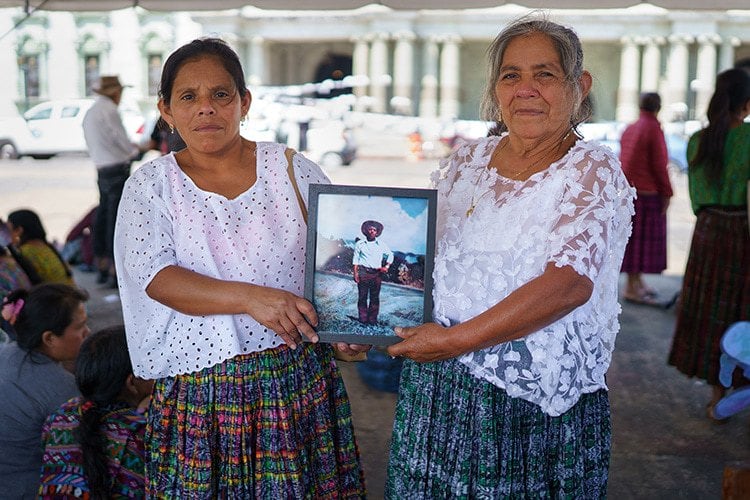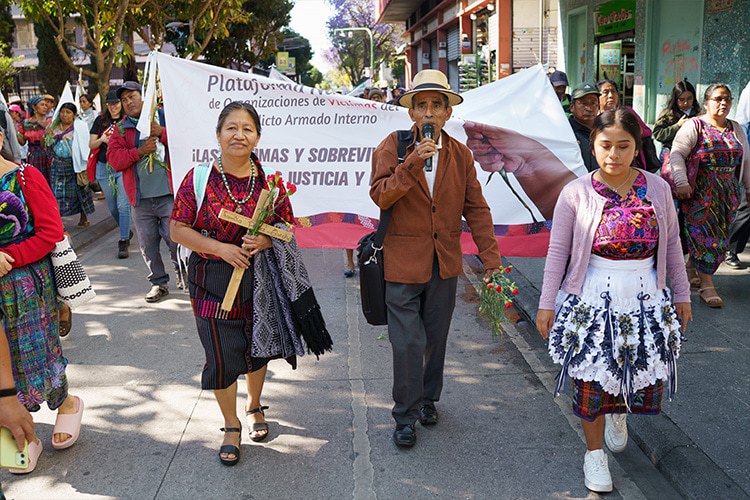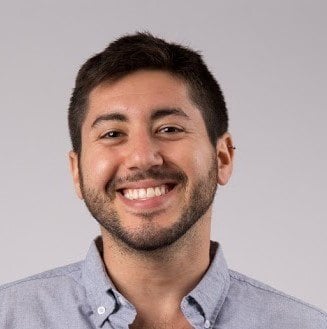Standing in Guatemala City’s historic Plaza de la Constitución, 42-year-old Elvira Cojoc gripped a framed, faded photograph of a farmer working his field. It’s the closest she’s come to meeting her father, Martin, who was abducted and disappeared by the Guatemalan military in 1982 — just months before she was born. Her mother, Dolores, stood by her side.
“I’ve been fighting for justice since I was in the womb,” said Elvira, a member of Guatemala’s Poqomchi’ Maya Indigenous group. “We want to find his remains. We want a grave. We deserve at least this much.”
It was February 25, 2025, and Elvira had joined more than 500 Indigenous and rural Guatemalans in the capital for the annual march to honor the victims of the country’s 36-year civil war, which erupted into a genocide against Indigenous people in the 1980’s. Though peace accords were signed in 1996, nearly all promises made by the Guatemalan government — including reparations to surviving families, economic development and improved social services in rural areas — have gone unfulfilled. Today, many of these communities are still denied basic human rights like clean water, healthcare and public education, let alone the knowledge of where their disappeared family members were buried.

The march — from Guatemala’s supreme court to its presidential palace, winding through the center of Guatemala City — was organized by AJWS grantee National Platform of Organizations of Victims of the Internal Armed Conflict, or La Plataforma, a coalition of survivors’ organizations devoted to carrying forward the torch of justice. Representatives of nearly all of Guatemala’s 24 Indigenous groups joined the march thanks to AJWS funding — without the buses organized with AJWS support, many of these campesinos, or small-scale farmers, could not have afforded the trip. The impact of this small grant was profound — offering the country’s most marginalized people a feeling of dignity; and the assurance that their presence could be felt before the halls of power.
Elvira and Delores traveled nearly six hours, waking up at 2 a.m. to arrive in the capital on time to honor the memory of the more than 200,000 Indigenous people killed and the more than 45,000 disappeared — still maintaining hope that justice will be served.
Watch the video below, and march alongside La Plataforma’s growing movement.
“Our grandmothers struggled. Our mothers struggled. And now we face the struggle for justice ourselves. But let it stop with us,” said Feliciana Macario, one of La Plataforma’s Coordinators, and a member of the Quiché people. “We dream that our children, our grandchildren and their children will live with dignity. Let us pass to them a just world, and a better Guatemala.”
When the procession arrived at the presidential palace, La Plataforma’s spiritual leaders built a circle of wooden crosses, each with the name of a murdered or disappeared person. Inside the circle, they lit a ceremonial fire of candles and incense and prayed in their Indigenous languages — for dignity for the dead, and justice for the living. Some survivors and their families laid flowers on the altar. Others held signs and led chants; movement leaders, students and elderly survivors gave speeches.
“They cut our branches. They even chopped down our trunk. But they can never destroy our roots,” said Feliciana.
The mood was solemn but resolute. With hundreds gathered in the plaza, their voices could not be ignored. After about two hours, representatives of Guatemala’s President Bernardo Arévalo invited La Plataforma’s leaders, including Feliciana and coordinator Juan Pérez Cedillo, inside for a meeting. It was Indigenous social movements, after all, who led the charge in 2023 when government officials tried to block Arévalo from taking office — Indigenous communities that formed the backbone of Guatemala’s pro-democracy movement. While Arévalo has effectively been blocked from action by a cohort of government leaders tied to the military (called ‘The Pact of the Corrupt’ by many Guatemalans), La Plataforma refuses to cower.
The crowd stood by, hopeful, patient, determined.
“We’ve been waiting for 40 years,” said one campesino. “What’s a few more hours?”

When Feliciana and Juan emerged later that afternoon, escorted by government officers, Juan smiled but shook his head. In the meeting, President Arévalo’s representatives had agreed to another meeting, down the road, to discuss a path forward. No one was satisfied, but no one was giving up. The hallway leading to the doorway of justice had just gotten longer — but the door could still be opened.
“Our ongoing negotiations with the government have not accomplished much. This is the difficult truth. But I believe the greatest impact we’ve had is supporting the mental health of survivors. Maybe that’s not a visible impact to outsiders. But we are re-activating people’s emotions: their joy, their hope,” said Feliciana. “What we can’t do — what is completely impermissible to do — is to lose hope.”


